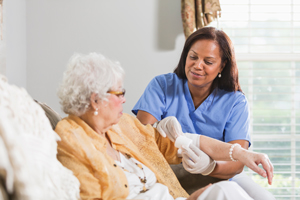 The newly implemented Patient-Driven Payment Model is already affecting how your acute-care customers are being reimbursed for the prevention and management of their residents’ wounds, including pressure ulcers, diabetic foot ulcers, arterial wounds and other skin-related conditions. This spring and summer offer many opportunities to get up to speed on the subject.
The newly implemented Patient-Driven Payment Model is already affecting how your acute-care customers are being reimbursed for the prevention and management of their residents’ wounds, including pressure ulcers, diabetic foot ulcers, arterial wounds and other skin-related conditions. This spring and summer offer many opportunities to get up to speed on the subject.
In fact, 2020 is a good time for Repertoire readers to learn more about wound care and about those who are most often on the front lines: nurses. That’s because the World Health Association has designated 2020 – the bicentenary of the birth of the founder of modern nursing, Florence Nightingale – The Year of the Nurse and the Midwife.
The American Health Care Association announced “Sharing Our Wisdom” as the 2020 theme for National Skilled Care Nursing Week, which will be held May 10-16. Established by the AHCA in 1967, NSNCW, formerly known as National Nursing Home Week, recognizes the essential role of skilled nursing care centers in caring for America’s frail, elderly, and disabled. NSNCW promotional materials can be downloaded at www.ahcancal.org/NSNCW.
Here are other wound-care-related events and conferences to be held in 2020.
The American Association of Post-Acute Nursing (www.AAPACN.org) will host its 2020 Conference – The Year of the Nurse – from April 15-17 in Atlanta. AAPACN represents more than 17,000 long-term and post-acute care nurses and professionals working in more than 5,750 facilities through its subsidiary associations, the American Association of Nurse Assessment Coordination (AANAC) and the American Association of Directors of Nursing Services (AADNS).
Among the pre-Conference workshops will be “ICD-10 CM Coding Certificate Program for SNFs,” taught by Carol Maher, RN-BC, RAC-MTA, RAC-MT, CPC, Hansen Hunter & Co. The Patient-Driven Payment Model (PDPM) has increased the importance of accurate ICD-10-CM diagnoses by shifting Medicare payments from therapy volume to resident characteristics, says AAPACN. ICD-10-CM codes and diagnoses will impact the OT, PT, SLP, NTA, and nursing components under PDPM. Maher will walk attendees through the process for using the ICD-10-CM Manual, from identification of the main term through the final code selection, and review coding and chapter-specific guidelines.
The National Association of Directors of Nursing Administration in Long Term Care (www.NADONA.org) will hold its 33rd National Conference June 14-17 in Niagara Falls, New York. NADONA says the conference is the largest annual meeting of nurse executives working in long-term and post-acute care. The organization has 35 state chapters.
Wound Ostomy and Continence Nurses Society (www.WOCN.org) will hold its 2020 educational event – WOCNNext – June 7-10 in Cleveland, Ohio. With more than 60 speakers and over 50 sessions to choose from, attendees will leave WOCNext with diverse knowledge and insights into how to best identify, care for, and overcome some of the most challenging issues facing their patient populations, according to WOCN. The education at WOCNext will be presented under the following healthcare themes:
- Wellness: Behaviors, actions and interventions to promote health and well-being.
- Symptom science: Understanding pathophysiology and manifestations of acute and chronic illness.
- Quality: Measures of patient-centered, safe, effective, timely, efficient and equitable care.
- Clinical care innovations: Advancing practice through the integration of education and research.
The 2020 Post-Acute Care Symposium (www.pacsymposium.com) will be held May 15-16 in San Diego, California, and will be co-located with the Symposium on Advanced Wound Care Spring/Wound Health Society (SAWC Spring/WHS) Conference. The symposium is designed to provide professionals in post-acute facilities the tools they need to meet day-to-day challenges with a curriculum that focuses on the strategies necessary for implementing clinical practice guidelines, protocols, and care pathways for wound and incontinence interventions. This year’s meeting will be a multidisciplinary approach and focus on reimbursement changes with PDPM and the Patient-Driven Groupings Model (PDGM, the new home care case-mix classification system.